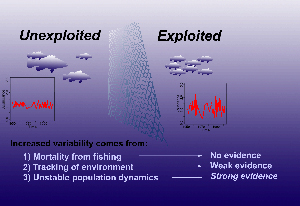

 |
|||
|
::: Assistant Professor Chih-hao Hsieh's Research Published in "Nature" Magazine!
Composed of scientists from UK, US, and Asian countries, this research team found evidence of the effect of fishing on the commercially exploited fish populations. This study, published in the April issue of Nature, indicates that fishing is basically size-selective in that it tends to remove large individuals in the fish population and leave only the fast growing younglings. Over the long haul, commercial fishing will result in the low-age phenomenon of the "age pyramid" of the fish population by lopping off the few large older fish that make up the top of the pyramid and leaving a broad base of faster growing small younglings. The research team finds that this rapidly growing and transitory base of younger fish is dynamically unstable, and that the number of fish will increase significantly with time, thus raising the danger of ethnic disintegration. This finding has profound influence for fishing management and the sustainability of ecosystem. Therefore, the News and Views of Nature magazine emphasized the importance of this research, Science Daily and Reuters, etc., made detailed reports of it. Traditionally, the fishing industry selectively catches the large-sized fish, and, in order to protect smaller fish, most fishing regulations impose restrictions only on the size of the smallest mesh. As a result, the fishing policies based on maintaining the population of target species often overlook the importance of size and age structure toward the dynamic stability of the target fish, and fail to take into account the risk of the ethnic disintegration of the whole species caused by the decrease in the number of large fish. Such a risk could expand to permeate the whole ecosystem, and, like the crash of the stock market or the domino effect, eventually endanger the fishing industry itself and related industries. The study is based on data gathered from a research program that has monitored fish and oceanographic activities of the California Currents for more than 50 years. From this study it can be ascertained that long-term ecological monitoring programs are essential to fishing management and sustainable development of ecosystems. ※References and Websites:
※Professor Hsieh's personal website:http://homepage.ntu.edu.tw/~complex/ecoinformatics_c.html Copyright 2008 NTU Secretariat |
No. 1, Sec. 4, Roosevelt Road, Taipei, 10617 Taiwan(R.O.C.)
Phone: +886-2-3366-3366 Fax: +886-2-2362-7651